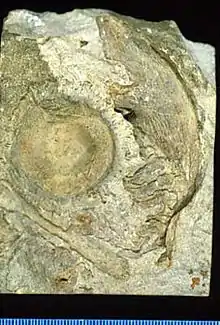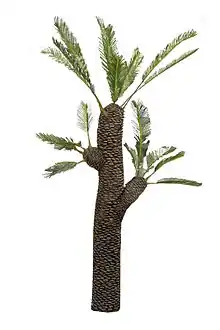Williamsonia (plant)
Williamsonia is an extinct genus of plant belonging to Bennettitales, an order of seed plants which bore a resemblance to cycads. Fossilized specimens of Williamsonia have been discovered worldwide.[1][3]
| Williamsonia | |
|---|---|
 | |
| Fossil seed cone of Williamsonia from the Jurassic period | |
| Scientific classification | |
| Kingdom: | |
| (unranked): | |
| Division: | |
| Order: | |
| Family: | |
| Genus: | Williamsonia |
| Type species | |
| Williamsonia gigas Carruth., 1870[2] | |
 | |
Areas where Williamsonia has been found | |
Taxonomy
Williamsonia was originally described as Zamia gigas by William Crawford Williamson.[4] William Carruthers proposed the name Williamsonia in an 1870 paper of his, with the type species being W. gigas.[2]
Biology

Williamsonia possessed a sturdy stem and had multiple fern-like leaves. The plant did not live in groups. The stamens of Williamsonia curved inward and upward.[3]
Williamsonia produced ovulate sporophylls up to 4 inches (10 cm) in length.[1] Its stalked seeds would have grown from a central receptacle, and the entire cone of Williamsonia would have been surrounded by protective bracts (which are often the only part of the plant to undergo fossilization).[1] The cones of Williamsonia were monosporangiate. They were "cup shaped" and could be up to 15 centimetres (5.9 in) in diameter. As many as 25-50 ovules could be present in each cone.[5] The development of the ovules appears to be similar to that of Cycadeoidea.[5]
Fossil sites
An anatomically preserved cone of Williamsonia has been discovered in Campanian rocks of Vancouver Island. This was the first reproductive structure of Williamsoniaceae to be recovered from western North America.[6] Bennettitalean cones (8 centimetres (3.1 in) in length and 6 centimetres (2.4 in) in diameter) from the Crato Formation of Brazil may belong to Williamsonia,[7] as well as finds from the Gristhorpe Beds of Cayton, England (in this case the specific species W. leckenbyi).[8] In addition, W. harrisiana has been described from the Rajmahal Hills of India,[9] as well as W. nizhonia from the Chinle Formation of New Mexico.[10]
In Brazil, it was found Williamsonia in Paleorrota geopark that were in the Santa Maria Formation, dating from Carnian, Upper Triassic.[11][12]
References
- Palmer, Douglas; et al. (2009). Prehistoric Life: The Definitive Visual History of Life on Earth (1st American ed.). New York: Dorling Kindersley. p. 230. ISBN 978-0-7566-5573-0.
- Seward, A. C. (2011). Fossil Plants: A Text-Book for Students of Botany and Geology. Cambridge, New York: Cambridge University Press. p. 421. ISBN 978-1-108-01597-4. Retrieved February 7, 2012.
- Firefly Guide to Fossils (illustrated ed.). Firefly Books. 2003. p. 174. ISBN 978-1-55297-812-2. Retrieved February 8, 2012.
- Reddy, S. M.; Chary, S. J. (2003). University Botany 2: Gymnosperms, Plant Anatomy, Genetics, Ecology. 2. New Delhi: New Age International. p. 12. ISBN 978-81-224-1477-6. Retrieved February 8, 2012.
- Taylor, Thomas N.; Taylor, Edith L.; Krings, Michael (2009). "Cycadophytes". Paleobotany: The Biology and Evolution of Fossil Plants (2nd ed.). Amsterdam: Academic Press. p. 734. ISBN 978-0-12-373972-8. Retrieved February 8, 2012.
- Stockey, Ruth A.; Rothwell, Gar W. (March 2003). "Anatomically Preserved Williamsonia (Williamsoniaceae): Evidence for Bennettitalean Reproduction in the Late Cretaceous of Western North America". International Journal of Plant Sciences. 164 (2): 251–262. doi:10.1086/346166. JSTOR 10.1086/346166.
- Martill, David M.; Bechly, Günter; Loveridge, Robert F. (2007). The Crato Fossil Beds of Brazil: Window into an Ancient World (illustrated ed.). Cambridge University Press. p. 542. ISBN 978-0-521-85867-0. Retrieved February 8, 2012.
- Crane, Peter R.; Herendeen, Patrick S. (January 2009). "Bennettitales from the Grisethorpe Bed (Middle Jurassic) at Cayton Bay, Yorkshire, UK". American Journal of Botany. 96 (1): 284–295. doi:10.3732/ajb.0800193. PMID 21628189. Retrieved February 9, 2012.
- Bose, M. N. (July 1968). "A new species of Williamsonia from the Rajmahal Hills, India". Journal of the Linnean Society of London, Botany. 61 (384): 121–127. doi:10.1111/j.1095-8339.1968.tb00109.x.
- Ash, Sidney R. (July 1968). "A new species of Williamsonia from the Upper Triassic Chinle Formation of New Mexico". Journal of the Linnean Society of London, Botany. 61 (384): 113–120. doi:10.1111/j.1095-8339.1968.tb00108.x.
- Passo das Tropas, Santa Maria, RS. Marco bioestratigráfico triássico na evolução paleoflorística do Gondwana na Bacia do Paraná
- PRESENÇA DE BENETTITALES NO TRIÁSSICO SUL RIOGRANDENSE: O GÊNERO WILLIAMSONIA CARRUTHERS